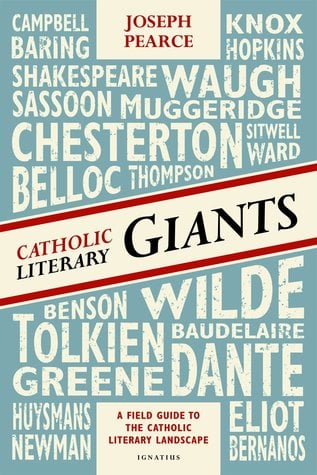Art and literature are powerful mediums to convey timeless truths. In the Introduction to Catholic Literary Giants, Joseph Pearce declares the power of art to evangelize, a defense of the Catholic Faith he terms the “apologetics of beauty.” He cites Dante, Shakespeare, Hopkins, Tolkien, and Waugh as a Catholic’s literary “weapons” to wield against the gloom of our darkened age. Pearce discusses all of these writers and more, to a greater or lesser degree, over the 67 essays that make up the book, most of them previously published in a variety of journals. He has grouped them into five parts: Tradition and Conversion, The Chesterbelloc, The Wasteland, J.R.R. Tolkien and the Inklings, and More Things Considered. Taken as a whole, the collection—through literary criticism, reviews, and other essays—demonstrates Pearce’s unique insight into, and extensive knowledge of, Catholic writers over the last century. Pearce covers other topics as well, including filmmaking, the visual arts, and feminism.
In “The Chesterbelloc: Examining the Beauty of the Beast,” Pearce discusses the literary merits of G.K. Chesterton and Hilaire Belloc, comparing them as poets, novelists, and socioeconomic and political commentators, as well as defenders of the Faith and apologists. “G.K. Chesterton: Champion of Orthodoxy” considers two of his most popular works, Orthodoxy and The Everlasting Man, and how these books were a great influence on many Christian writers who came after him. “Belloc’s The Path to Rome” can be read on many levels, Pearce argues, and “The author’s pilgrimage to Rome is a microcosmic metaphor for Everyman’s pilgrimage through life.” The Chesterbelloc section also includes essays on such lesser-known contemporaries as Maurice Baring and R.H. Benson.
“Entrenched Passion: The Poetry of War” leads into Pearce’s Wasteland, providing an insightful look at how war poetry has changed from the Middle Ages to the 20th century. And in “Emerging From the Wasteland: The Cultural Reaction to the Desert of Modernity,” Pearce shows how the periods following each of the world wars produced remarkably great literature. While Siegfried Sassoon, T.S. Eliot, and Roy Campbell take center stage in this section of the book, other players include Edith Sitwell, Evelyn Waugh, Graham Greene, and Malcolm Muggeridge.
My favorite part of the collection is the fourth, J.R.R. Tolkien and the Inklings. “The Individual and Community in Tolkien’s Middle Earth” compares Tolkien’s political and cultural outlook with that of Chesterton and Belloc, “True North” discusses Catholicism and northern mythology, and “Tolkien and the Catholic Literary Revival” contends that Tolkien should be considered a part of the Catholic literary revival. If there is a fault to this section of the book, it is that a few of the essays retread some of the ground Pearce covered in his Tolkien: Man and Myth. Nonetheless, even those familiar with the earlier work will find plenty of new material here. This section concludes with a touching essay on Owen Barfield, the last surviving Inkling, whom Pearce had the opportunity to meet just before Barfield’s death.
More Things Considered covers topics ranging from modern art to film to technology. Oscar Wilde gets the most space. In “The Quest for the Real Oscar,” Pearce argues that, while people remain fascinated by Wilde’s decadent side, they should focus more on his art, where the Catholic dimension to his life is discernible. Pearce expands on this point in “Making Oscar Wild,” where he shows Wilde as a man who referred to his homosexuality as his “pathology.” Pearce also gives attention to Dante, Shakespeare, and, surprisingly, Paul McCartney, whom Pearce considers “a poet in spite of his reputation as a songwriter, not because of it.” “Purity and Passion” defends and supports Mel Gibson’s The Passion of the Christ, and “The Presence That Christmas Presents” looks at Christmas—what it is not, and what it is.
Catholic Literary Giants enriches readers with Pearce’s broad knowledge not only of the Catholic literary world but of art and culture. It is an exemplar of the apologetics of beauty.
[Catholic Literary Giants: A Field Guide to the Catholic Literary Landscape, by Joseph Pearce (San Francisco: Ignatius Press) 425 pp., $21.95]

Leave a Reply